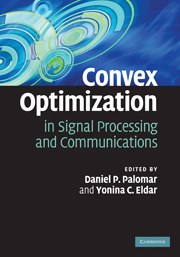Book contents
- Frontmatter
- Contents
- List of contributors
- Preface
- 1 Automatic code generation for real-time convex optimization
- 2 Gradient-based algorithms with applications to signal-recovery problems
- 3 Graphical models of autoregressive processes
- 4 SDP relaxation of homogeneous quadratic optimization: approximation bounds and applications
- 5 Probabilistic analysis of semidefinite relaxation detectors for multiple-input, multiple-output systems
- 6 Semidefinite programming, matrix decomposition, and radar code design
- 7 Convex analysis for non-negative blind source separation with application in imaging
- 8 Optimization techniques in modern sampling theory
- 9 Robust broadband adaptive beamforming using convex optimization
- 10 Cooperative distributed multi-agent optimization
- 11 Competitive optimization of cognitive radio MIMO systems via game theory
- 12 Nash equilibria: the variational approach
- Afterword
- Index
4 - SDP relaxation of homogeneous quadratic optimization: approximation bounds and applications
Published online by Cambridge University Press: 23 February 2011
- Frontmatter
- Contents
- List of contributors
- Preface
- 1 Automatic code generation for real-time convex optimization
- 2 Gradient-based algorithms with applications to signal-recovery problems
- 3 Graphical models of autoregressive processes
- 4 SDP relaxation of homogeneous quadratic optimization: approximation bounds and applications
- 5 Probabilistic analysis of semidefinite relaxation detectors for multiple-input, multiple-output systems
- 6 Semidefinite programming, matrix decomposition, and radar code design
- 7 Convex analysis for non-negative blind source separation with application in imaging
- 8 Optimization techniques in modern sampling theory
- 9 Robust broadband adaptive beamforming using convex optimization
- 10 Cooperative distributed multi-agent optimization
- 11 Competitive optimization of cognitive radio MIMO systems via game theory
- 12 Nash equilibria: the variational approach
- Afterword
- Index
Summary
Many important engineering problems can be cast in the form of a quadratically constrained quadratic program (QCQP) or a fractional QCQP. In general, these problems are nonconvex and NP-hard. This chapter introduces a semidefinite programming (SDP) relaxation procedure for this class of quadratic optimization problems which can generate a provably approximately optimal solution with a randomized polynomial time complexity. We illustrate the use of SDP relaxation in the context of downlink transmit beamforming, and show that the SDP relaxation approach can either generate the global optimum solution, or provide an approximately optimal solution with a guaranteed worst-case approximation performance. Moreover, we describe how the SDP relaxation approach can be used in magnitude filter design and in magnetic resonance imaging systems.
Introduction
In this chapter, we consider several classes of nonconvex quadratic constrained quadratic programs (QCQPs) and a class of nonconvex fractional QCQPs. The importance of these classes of problems lies in their wide-ranging applications in signal processing and communications which include:
the Boolean least-squares (LS) problem in digital communications [1];
the noncoherent maximum-likelihood detection problem in multiple-input multipleoutput (MIMO) communications [2, 3];
the MAXCUT problem in network optimization [4];
the large-margin parameter estimation problem in automatic speech recognition [5–8];
the optimum coded waveform design for radar detection [9];
the image segmentation problem in pattern recognition [10];
the magnitude filter design problem in digital signal processing [11];
the transmit B1 shim and specific absorption rate computation in magnetic resonance imaging (MRI) systems [12, 13];
[…]
Information
- Type
- Chapter
- Information
- Convex Optimization in Signal Processing and Communications , pp. 117 - 165Publisher: Cambridge University PressPrint publication year: 2009
Accessibility standard: Unknown
Why this information is here
This section outlines the accessibility features of this content - including support for screen readers, full keyboard navigation and high-contrast display options. This may not be relevant for you.Accessibility Information
- 24
- Cited by
